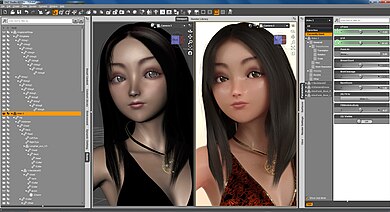Daz Studio
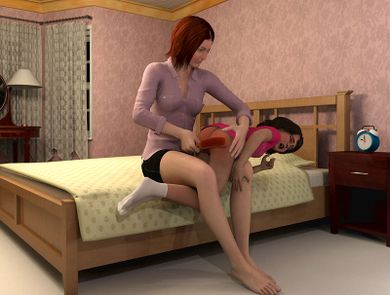
Daz Studio[Source 1] is a free 3D scene creation and rendering software developed by Daz 3D Inc. While the base product is free (registration is required), many more advanced features require purchasing products from vendors or finding free alternatives.
Daz Studio can be used to produce images as well as animations (video), however, the latter can be frustrating and highly time-consuming to do. Daz is not optimized for fast rendering or animation. It is mainly made for rendering at high resolution.
Daz Studio is available for Mac OS X and Microsoft Windows. Until version 1.7 it was officially known as DAZ|Studio. Version 1.0 was released in Fall 2005. Daz Studio 3.0 was released in June 2009. As of October 2022, the latest stable version is 4.21.0.5.
General information
Comparison to Poser
Daz Studio was created as a direct alternative to Poser, but following a different business model.
Poser provides a large set of components, not all essential to the creation of imagery, in a commercially available program. Daz Studio provides a core free of charge program with the required features for the creation of imagery, while relegating other features to add-on 'plug-ins', usually commercially available, which the user may add as required. Some users hold that this means that Daz Studio is incomplete in comparison to Poser, others that it allows users to tailor the tool to their individual needs as their use of it evolves.
Daz Studio supports the import and export of various file formats for 3D objects. It is capable of importing most Poser content, with the notable exceptions of dynamic clothing and dynamic hair. As a result of the different lighting models, lights may need to be tweaked or replaced and while textures are generally usable between the two (other than Poser node-based materials), optimum results may need slightly different lighting values for each.
Lighting and HDRI maps
Lighting is very important as it greatly affects the rendered image. The technical details of lighting are quite complicated. In Daz Studio, the Environment Mode decides how the lighting is handled and set up in your scene.
A great help is to use an HDRI map.[1] It adds an outside image together with light from the outside to your scene. Free HDRI maps are available for example from Poly Haven.
How to get quick results:
- Load a scene you like to play around with (like a bedroom). Check how the pre-built scene looks.
- Change the HDRI map[2] to change what is visible through the windows. The HDRI map will also illuminate your scene as a base light.
- To refine the lighting, add or change object light sources such as lamps. You can use traditional Lights — e.g. spot lights — or, in a newer fashion, Ghost Lights (surfaces that emit light).
Note that HDRI maps are not visible in Viewport except in NVIDIA Iray mode (which will slow the computer down considerably). You can see that in the two images of the following section.
Viewport and render
In Daz Studio, creators see a preview of their scene with something called Viewport. They can choose from different preview modes to work and edit their scene/setting. Viewport is optimized for speed, not for image quality. Everything displayed in viewport is of lower quality than the real rendering.[3] Here is an example:
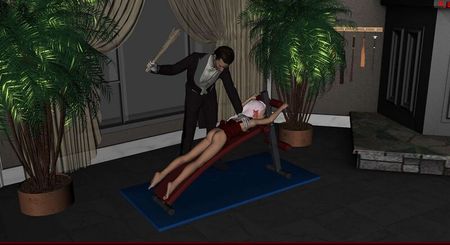
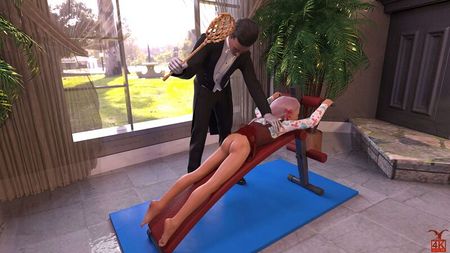
There are different render engines. In the old days (until 2015 and perhaps a few years more), most Daz Studio users used the built-in 3Delight render engine. By today's standards, it creates ugly output. In 2015, the Iray render engine came out, which most users now use by default. Iray is by NVIDIA and needs an NVIDIA graphics card. Using a GPU is greatly recommended anyway as it greatly speeds up the process compared to CPU rendering. Both the 3Delight and the Iray engine are free. You can also use other render engines, which typically are not free but have to be purchased.
Fully rendering an image can take a very long time, but it is not necessary to wait for a full render to complete. Rendering is done in iterations and you can also, for example, stop at 2% render progress. The longer you render, the more detail you will get.
Denoising
Depending on many factors, noise can be caused in the rendered image. There can also be so-called "fireflies", anomalously-bright single pixels scattered over parts of the image.
In such cases, you may want to use a denoiser after rendering. There are different denoisers available on the market. Recommended is the Intel OIDN (Open Image Denoise).
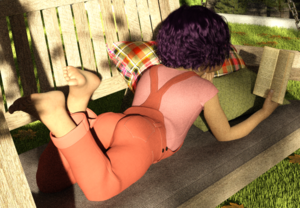
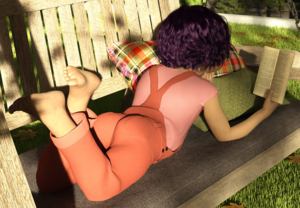
View and compare the images in full resolution to see the difference.
Characters, shapes and morphs
Daz 3D has had many versions of its human figures and characters, but in 2011, they launched a significant change in the underlying technology. Instead of each figure being designed individually, Daz 3D moved to their Genesis platform, in which figures were derived as morphs from the base mesh.[4] Two of the key differences that this technology created were: The ability for characters to be blended into a huge variety of shapes; and since these shapes were all derived from a common base, add-on content like clothing, hair, and additional morphs would not only work on all characters but could actually change with the characters.
- Genesis (G1) — a unisex series. A slider can change the characters between female and male.
- Genesis 2 (G2) — a gender splitted series. It has two distinct base figures, a male and a female.
- Genesis 3 (G3) — a gender splitted series that uses a different technology which allows Daz 3D's figures to be more compatible with other 3D software platforms as well as game development platforms.
- Genesis 8 (G8/8.1) — a gender splitted series. Includes significant changes in the figure's backward compatibility with previous generations and their content, as well as joint and muscle bends and flexing and facial expressions.
- Genesis 9 (G9) — a unisex series. A slider can change the characters between female and male.
The letter F and M after something like G8 stands for female and male.
Shapes, in Daz Studio, are sliders to morph (transform) a character. For example, you can use it to make the character older or younger, more male or more female, slimmer or more obese, more or less muscular, etc.
Creating spanking art with Daz Studio
| Note: This article is about Daz Studio for a website, see : HP |
|---|
- This article is about a Spanking website
| “ | A Web Site Devoted to Old-Fashioned Discipline of Make-Believe Children. | ” |
Handprints is probably the world's biggest free web gallery of girl spanking art, founded in 1999. Its webmaster is HandPrince (sometimes spelled "Handprince", "Hand Prince" or "HP"). Handprince himself doesn't draw or paint, except for image revisions, but is the author of a number of girl spanking stories and spanking verse.
The site contains girl spanking art in mainstream comics (such as Little Audrey, Little Dot, Little Iodine, Nancy and Li'l Jinx), girl spanking drawings by various artists (as of December 2019, 226 galleries), girl spanking animations, girl spanking stories, spanking jokes, spanking poems, and a collection of links.
Since December 2015, you can embed external images from Handprints into this wiki using Template:Handprints.
History
Handprints was originally hosted on Yahoo! GeoCities. Due to its great popularity and Yahoo!'s restrictive bandwidth limitations the site was often temporarily unavailable for viewing. In or before 2007, Handprints moved to a different server — first called dawnoffreedom.com, then thehandprints.com, hosted by Anime OTK — and its availability greatly improved.
In 2015, the site suffered a crash and was rebuilt using an outdated backup. It took several weeks until it was fully restored on 25 December 2015.
See also
- Handprint
- Boyz Being Boyz (similar concept; free site for boy spanking art)
Links
- Handprints
- Handprints: What's New
- Handprints Guestbook 1 (2010-2012)
- Handprints Guestbook 2 (2007-2011)
- Handprints Guestbook 3 (2013- )
Chat rooms • What links here • Copyright info • Contact information • Category:Root
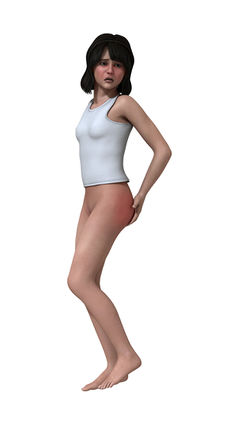
The following tips by Spanktastic might be helpful for people who want to create rendered spanking art with Daz Studio.
Useful Daz bundles, plug-ins and tools
- dForce Companion 2.0: very helpful to help simulating clothes or objects, like letting underpants slide down.
- Growing Up Bundle for Genesis 8 Female(s) and Male(s): to easily transform an adult character into a child character.
- Mesh Grabber Bundle (Mac), Mesh Grabber Bundle (Win): allows you to manipulate any object geometry from within Daz Studio without having to resort to external modeling software. An absolute must-have.
- SY Invisilights Iray: for adding invisible lights (they are visible in the viewport but invisible in the renders except for the light they emit).
- Thickener Plug-In: for adding a thickness to open-mesh objects (e.g. clothing), converting them into closed-mesh objects.
Useful Daz product vendors
The following vendors sell products that can be useful for spanking scenes. Some of them are completely mainstream, some are adult oriented, and some target BDSM art creators):
- Vendors on daz3d.com:
- 3D Universe: child characters, usually also including new (optional) hair and child-fitting clothes
- Censored: many nice single props
- Fugazi1968: furnished rooms that make good settings for spanking and other punishments
- KindredArts: environment design, visual effects, props. For example, dForce ready clothing items (if you want clothes lying around), beds, etc.
- maclean: daily props which are very detailed and flexible
- Mely3D: many sets, mainly sci-fi, fantasy, but also others, like a playground, prisons, examination rooms and many more
- PW Productions: high quality settings and props
- SilvaAnt3d: props and rooms, such as baking tools, a children's corner and other family sets
- Tesla3dCorp: good environments such as schools, useful as settings for school corporal punishment scenes
- Transgender Shapes for Genesis 8: the name says it
- Vendors on Renderosity -- All products for Daz on Renderosity
- Angel_Wings's Store: cute kids
- dzheng's Store: sexy clothes and often gay BDSM related outfits
- JaReHorse's Store: male G8 clothes. Often with easy access to the naughty parts
- nirvy's Store: easy to spank and undress clothes, mainly female
- Sangriart's Store: popular characters like Emma Watson or Galandriel from Lord of the Rings
- sparkman's Store: easy to undress clothes
- Vendors on Renderotica -- Renderotica - 3D Content (adult 3D products)
- Products by Davo on Renderotica
- Products by powerage on Renderotica
- Products by SynfulMindz on Renderotica
- Products by vokhsor on Renderotica
- Products by Vunter Slaush on Renderotica
- Free products:
- CGBaby_Diaper-v2 (free download, no official store): a diaper for G8F that can also be used on G8M
- Freebies and Tutorials by Noone102000 on Deviant Art
- ShareCG: a site with both free and for-pay products. Some of them are Daz Studio compatible.
- shredder's Gallery: Some free Daz Studio compatible products, such as a Japanese school and classroom
- yomiuri's Gallery: (Mainly) Japanese clothes for girls, free and Daz Studio compatible
Spanking artists and pay sites who use Daz Studio
Artists who use Daz Studio to create rendered spanking art include CopyKats, KajiraGames, Mayhem, Rude Rumps, Salalo and Spanktastic.
A pay site that features spanking artwork created with Daz Studio is Spank Red.
See also
Footnotes
- ↑ HDRI (High Dynamic Range Image) refers to images with a greater than normal dynamic range. An HDRI map (also spelled HDRi map) however is something different: it is a 360-degree image (a sphere projected onto a rectangle) that includes lighting information as well as visuals, and can be used for lighting CG scenes. Confusingly, many Daz users call an HDRI map just an HDRI. For more information, see What is an HDRi Map? Detailed Explanation and Real-World Examples.
- ↑ Go to Render Settings → Environment → Environment map and click on the HDRI map image. A tiny preview is shown. Choose the one you want out of your HDRI Folder. Optionally, go to your content library to Light presets and choose one of your products if you installed any.
- ↑ Viewport's mode "NVIDIA Iray" will show the final light setup and create an image similar to the render, but it doesn't render in full resolution and has no save button.
- ↑ A morph is something that can modify the structure of a 3D object following certain predefined rules. For example, a morph can change a table's height, length, or width, while keeping the width of the table's legs unchanged.
Sources
External links
- Daz 3D
- Daz 3D Install Manager (DIM) -- Note: You need DIM to install Daz Stu dio, for updates and for very rare situations where a plugin requires that installer. But you do not usually need DIM to install content for it, and it is highly recommended to install everything just by unzipping the downloaded .zip and drag it into your /My library/ folder.
- Daz Studio on the Poserpedia wiki
- How to create rendered spanking art with Daz Studio (Adult site), archived page, not all images are included
| This page may use content from Wikipedia. The original article was at Daz Studio. The list of authors can be seen in the page history. |
Chat rooms • What links here • Copyright info • Contact information • Category:Root
